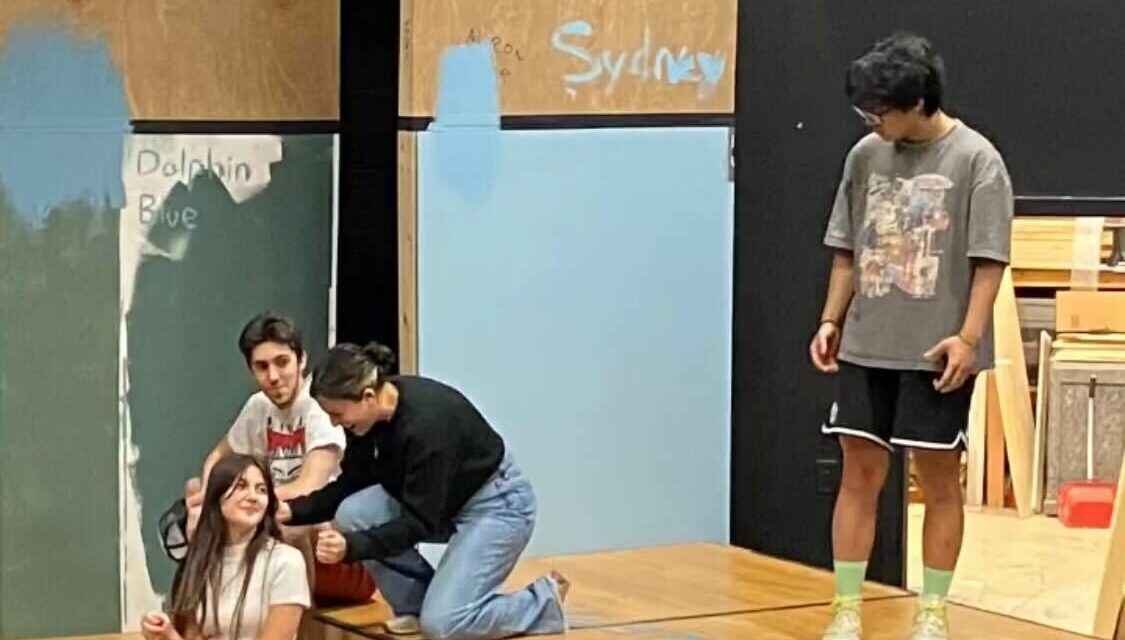Play posters line the hallways of Tarbutton Performing Arts Center at Oxford College of Emory University. A wooden bench and a stone sculpture form a dynamic entryway to the theater.
A giant blue set sits in the middle of the room. A box of electric wires lie carelessly on the floor. A wood frame is propped up in the corner. Tarbutton buzzes with a quiet, mysterious excitement. Play rehearsal is in progress.
OxTheatre’s production of “Snowflakes, or Rare White People,” an adaptation of Dustin H. Chinn’s play, opened on Oct. 19 and will run through Oct. 21.
University of California, Berkeley students first performed the play on Zoom in summer 2020, during the COVID-19 pandemic. Assistant Professor of Theater Nick Fesette, who is directing OxTheatre’s play, said there are significant differences between performing the play on Zoom versus in person.
Fesette described that the two features that make the play unique — its science fiction and comedic elements — are also the play’s biggest challenges.
Not giving away much of the story, he began by stating that the American Museum of Natural History in New York features the Gardner D. Stout Hall of Asian Peoples, a display he referred to as a horrific piece of racism.
The play seeks to turn this narrative of racism around, Fesette said. “Snowflakes, or Rare White People” takes place in Nueva New York in the 23rd century, where white people are a protected population. Two white people, Benedict and Meghan, are brought to the Hall of Caucasian Peoples as living exhibits. They are eventually freed by Rigoberto Rogers, a gift shop employee.
 (Courtesy of Nick Fesette)
(Courtesy of Nick Fesette)
“It’s a fictitious future or a speculative future, where white people have become a protected species, if you will, a protected group,” Fesette said. “The United States still exists, but has been radically changed because of climate change.”
Expanding on the plot, Fesette discussed the play’s racial themes.
“It’s a satire of what’s called the ‘great replacement myth,’ which is this idea that by 2040 something, white people will be the minority,” Fesette said.
The play also has innovatively-designed colorful costumes. During the rehearsal, each cast member went into the green room, where Stephanie He (25Ox) dressed them as their characters.
Dylan Jagla’s (24Ox) costume, a bright pink outfit complete with pink shoes and makeup, laid neatly on the dressing table. She plays Hassan Hernandez.
Wayne Wang (24Ox), who plays the protagonist Rigoberto Rogers, walked out of the green room dressed in a bright yellow coordinating set, with the words “How can I help you?” emblazoned on the back of his shirt.
“Each character has such a distinct personality,” He explained. “Our vision was to make them embody a color.”
With their costumes on, the cast began the rehearsal with a breathing exercise. Each member bent down and pretended to shrug off a sweater while breathing in deeply. A cacophony of voices filled the space.
The joy of making new art together shined clearly. With Fesette at the helm, the production team and cast have worked for the past two months to ensure a successful production of “Snowflakes, or Rare White People.”
“Perhaps I’ve waited all my life for a road trip, and I am a part of something diverse” is Wang’s favorite line in the play.
“It resonates with me because I’m an international student and to be a part of a production like this, I’m proud of it,” Wang said. “It’s just an amazing experience to talk to all of these people.”
Discussing why he brought this play to Oxford, Fesette said this satirical comedy engages deeply rooted social and political beliefs like racism and will spark important conversations.
“Whenever you put white people in the title of a play, people get tense, right?” Fesette said. “That kind of tells us about whiteness. It tells us that whiteness is a kind of paranoid structure, a structure that we can’t talk about … We can talk about Blackness, we can talk about people of color, we can talk about indigeneity… but don’t talk about whiteness.”
The characters’ names are evident ethnic stereotypes: The non-white characters are named Rigoberto Rogers, Hassan Hernandez, Fei Fong-Torres and Puja, while the white characters are named Benedict and Meghan.
“It’s more than just representing stereotypes,” Fesette added. “It’s framing them in a certain way so that the audience understands that they are stereotypes.”
He said the stereotypical names are a method to make racism seem ridiculous to help audiences confront the issue.
Fesette’s own research is also centered around critiquing and abolishing the notion of whiteness.
“My connection to the play comes, in part, from this research project,” Fesette said. “I’ve written on disinvesting from the project of whiteness, not just finding allyship in whiteness, but really undoing whiteness as much as possible, which is in part a cultural project. What I hope is that theater can be a part of that cultural project.”
Fesette said he hopes the audience’s first reaction to the play will be, “It’s hilarious!”
“It’s a very, very silly play,” Fesette said. “The predominant feeling watching it is going to be enjoying, amusement, pleasurable feelings related to how silly and goofy the play is.”
However, Fesette makes it clear that this humor should not mask the true intention behind the production, which is to acknowledge and address the ingrained social structure of racism. He hopes the laughter leads to thought, adding that the play should help the audience “mark the structures of whiteness in their daily life.”
“All the plays that I choose are opportunities for discussion, opportunities for bringing the student community, faculty, staff, local community, whoever comes to the plays, together and create a place to have fun, of course, but also use theater as a way to think about the world and talk about the world,” Fesette said.





